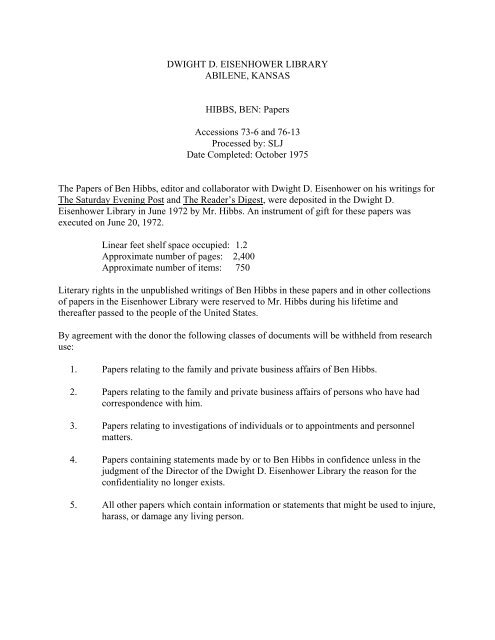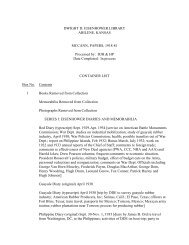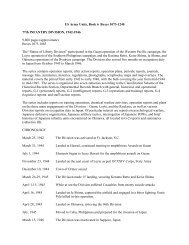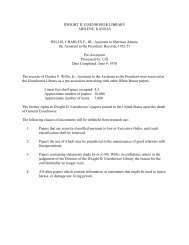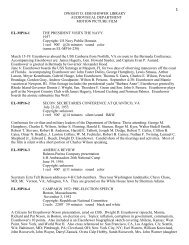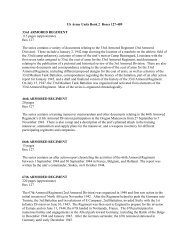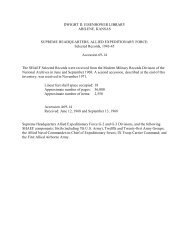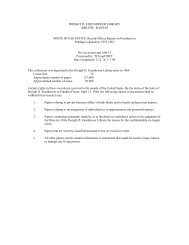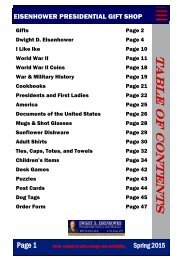hibbs, ben - Dwight D. Eisenhower Presidential Library and Museum
hibbs, ben - Dwight D. Eisenhower Presidential Library and Museum
hibbs, ben - Dwight D. Eisenhower Presidential Library and Museum
- No tags were found...
You also want an ePaper? Increase the reach of your titles
YUMPU automatically turns print PDFs into web optimized ePapers that Google loves.
DWIGHT D. EISENHOWER LIBRARYABILENE, KANSASHIBBS, BEN: PapersAccessions 73-6 <strong>and</strong> 76-13Processed by: SLJDate Completed: October 1975The Papers of Ben Hibbs, editor <strong>and</strong> collaborator with <strong>Dwight</strong> D. <strong>Eisenhower</strong> on his writings forThe Saturday Evening Post <strong>and</strong> The Reader’s Digest, were deposited in the <strong>Dwight</strong> D.<strong>Eisenhower</strong> <strong>Library</strong> in June 1972 by Mr. Hibbs. An instrument of gift for these papers wasexecuted on June 20, 1972.Linear feet shelf space occupied: 1.2Approximate number of pages: 2,400Approximate number of items: 750Literary rights in the unpublished writings of Ben Hibbs in these papers <strong>and</strong> in other collectionsof papers in the <strong>Eisenhower</strong> <strong>Library</strong> were reserved to Mr. Hibbs during his lifetime <strong>and</strong>thereafter passed to the people of the United States.By agreement with the donor the following classes of documents will be withheld from researchuse:1. Papers relating to the family <strong>and</strong> private business affairs of Ben Hibbs.2. Papers relating to the family <strong>and</strong> private business affairs of persons who have hadcorrespondence with him.3. Papers relating to investigations of individuals or to appointments <strong>and</strong> personnelmatters.4. Papers containing statements made by or to Ben Hibbs in confidence unless in thejudgment of the Director of the <strong>Dwight</strong> D. <strong>Eisenhower</strong> <strong>Library</strong> the reason for theconfidentiality no longer exists.5. All other papers which contain information or statements that might be used to injure,harass, or damage any living person.
BIOGRAPHICAL NOTEJuly 23, 1901Born, Fontana, Kansas1923 A.B., University of Kansas1923 News editor, Fort Morgan Times (Colorado)1924 News editor, Pratt Tribune (Kansas)1924-26 Professor of journalism, Hays State College (Kansas)1926-27 Editor <strong>and</strong> manager, Goodl<strong>and</strong> News-Republic (Kansas)1927-29 Managing editor, Arkansas City Traveler (Kansas)1929-40 Associate editor, The County Gentleman, Philadelphia, PennsylvaniaJune 3, 1930Married Edith Kathleen Doty1940-42 Editor, The Country Gentleman1942-61 Editor, The Saturday Evening Post1951-54 Member of United States Advisory Commission on Information1962 Senior editor, The Saturday Evening Post1963-72 Senior editor, The Reader’s Digest1975 DiedMr. Hibbs also served as a member of the Board of Trustees of the <strong>Eisenhower</strong> ExchangeFellowships.
SCOPE AND CONTENT NOTEThe Papers of Ben Hibbs span the years 1962-1969, when he served as collaborator with <strong>Dwight</strong>D. <strong>Eisenhower</strong> on nineteen articles written for publication in The Saturday Evening Post <strong>and</strong> TheReader’s Digest. The papers consist of correspondence <strong>and</strong> memor<strong>and</strong>a concerning the writingof these articles, <strong>and</strong> drafts of the articles themselves.In 1942 Ben Hibbs began a twenty-year association with the editorial staff of The SaturdayEvening Post. During the <strong>Eisenhower</strong> administration, Hibbs persuaded the President to sign acontract calling for him to write four articles a year for publication in The Post beginning after<strong>Eisenhower</strong> left the White House. During Hibbs’ final year with The Post, 1962, he served assenior editor <strong>and</strong> began working directly with General <strong>Eisenhower</strong> on articles he prepared for themagazine.Hibbs left The Post in January 1963 <strong>and</strong> joined the editorial staff of The Reader’s Digest, ownedby DeWitt Wallace. When <strong>Eisenhower</strong>’s contract with The Post expired in 1964, Hibbs wasresponsible for the General’s signing a new contract agreeing to write three articles a year for theReader’s Digest at a fee of $30,000 per article. Hibbs was the editor assigned to collaborate with<strong>Eisenhower</strong> in producing these articles.The general procedure followed in producing an <strong>Eisenhower</strong> article was begun when a topic,originated by the General, Hibbs, or Reader’s Digest editors, was decided upon. <strong>Eisenhower</strong> <strong>and</strong>Hibbs then agreed to a meeting time several weeks in advance <strong>and</strong> proceeded to accumulateideas <strong>and</strong> facts for the article. They would then meet several times at either Gettysburg or PalmSprings to discuss the article, working from an outline prepared by Hibbs. From theseconversations, <strong>and</strong> the notes Hibbs compiled from them, a draft of the article was created. It wasthen sent to <strong>Eisenhower</strong> for his comments <strong>and</strong> editing before being submitted to the executiveeditor of Reader’s Digest, Hobart Lewis, for final editing.Hibbs first met <strong>Eisenhower</strong> during the last year of World War II, when the General requestedthat reporters from the United States be flown to Europe to document the horrors of the Germanconcentration camps then being liberated by the U.S. Army. Hibbs <strong>and</strong> the other correspondentswere shown Dachau <strong>and</strong> Buchenwald <strong>and</strong> were then introduced to <strong>Eisenhower</strong> at his SHAEFheadquarters. Following the war, Hibbs attempted to purchase for The Post the magazine rightsto General <strong>Eisenhower</strong>’s memoirs, Crusade in Europe, but was unsuccessful when <strong>Eisenhower</strong>sold those rights to Life.Hibbs actively promoted the c<strong>and</strong>idacy of <strong>Eisenhower</strong> for the Presidency of the United States in1952. He wrote an editorial entitled “Will the Republicans Commit Suicide in Chicago”concerning the Taft-<strong>Eisenhower</strong> battle over the seating of Republican delegates from Texas.According to Hibbs, <strong>Eisenhower</strong> thought that particular editorial did “as much as anything elsethat was published” to get him the Republican nomination (see the transcript of Hibbs-Wickm<strong>and</strong>iscussion, page 16).Hibbs was never a part of the inner White House Group during the <strong>Eisenhower</strong> administrations.However, he did remain an acquaintance of the President <strong>and</strong> was invited to attend stag dinners
<strong>and</strong> other social functions. His close association with <strong>Eisenhower</strong> developed after the Presidentleft office <strong>and</strong> began writing articles for The Post <strong>and</strong> Reader’s Digest.The Ben Hibbs papers are arranged in three series. The first series consists of a twenty-four pagetranscript of a tape recording of a discussion between Mr. Hibbs <strong>and</strong> John E. Wickman, Directorof the <strong>Eisenhower</strong> <strong>Library</strong>. The discussion dealt primarily with Hibbs’ papers <strong>and</strong> his associationwith <strong>Eisenhower</strong> as collaborator on the General’s articles. Other topics of discussion includeHibbs’ meeting of <strong>Eisenhower</strong> in World War II, his support for the 1952 <strong>Eisenhower</strong> nomination<strong>and</strong> his futile effort to purchase the magazine rights to Crusade in Europe.The second series contains drafts of seventeen articles <strong>Eisenhower</strong> <strong>and</strong> Hibbs worked ontogether, <strong>and</strong> the related correspondence. These articles were written from January 1963 toFebruary 1969, <strong>and</strong> the final article, “America’s Tarnished Image,” was never published because<strong>Eisenhower</strong> died before it reached print. Hibbs marked the drafts, indicating which draft of thearticle (first, second, final) it was <strong>and</strong> who had done the editing of certain drafts. Many haveh<strong>and</strong>-written corrections <strong>and</strong> deletions done by <strong>Eisenhower</strong> himself. Also included with some ofthe draft articles are the spiral notebooks Hibbs filled during his discussions with <strong>Eisenhower</strong> onparticular topics. These notes on <strong>Eisenhower</strong>’s ideas became the basis for the first draft of eacharticle. The correspondence accompanying these drafts concerns the research <strong>and</strong> backgroundwork being done on an article, arrangements for payment, editing problems, schedules, <strong>and</strong>meetings.The third series consists of general correspondence arranged chronologically from 1962-1969.The 1962 material includes drafts <strong>and</strong> correspondence related to two 1962 <strong>Eisenhower</strong>-Hibbsarticles done for The Post. These are “Are We Headed In the Wrong Direction?”, August 11-18,1962 (the draft is entitled “My Views of the Kennedy Administration”), <strong>and</strong> “Ike Takes a Lookat the GOP,” April 21, 1962. Other correspondence in the series deals with ideas for futurearticles <strong>and</strong> with reaction to the articles by the public <strong>and</strong> the editors of Reader’s Digest.Principal correspondents include <strong>Eisenhower</strong>, Hibbs, Hobart Lewis, John S. D. <strong>Eisenhower</strong>, <strong>and</strong>Robert L. Schulz.The arrangement of this collection was devised by Mr. Hibbs before the papers were presented tothe <strong>Eisenhower</strong> <strong>Library</strong>. A staff archivist has provided the series <strong>and</strong> folder titles. The Hibbs’materials were received in two separate accessions which have been combined in this collection.Accession 73-6 includes all articles, drafts, <strong>and</strong> correspondence; <strong>and</strong> accession 76-13 includesthe taped discussion <strong>and</strong> typed transcripts (rough draft <strong>and</strong> final copy). The tape recording <strong>and</strong>the typed rough draft of the transcript were placed in the vault for security.
DESCRIPTION OF SERIESBox Nos. Series1 Transcript. Twenty-four page typed transcript of a taped discussion between BenHibbs <strong>and</strong> John Wickman concerning the papers Hibbs was presenting to the<strong>Eisenhower</strong> <strong>Library</strong>. Although the exact date of this discussion is unknown, itprobably took place sometime in 1972.1-3 Article drafts with related notes <strong>and</strong> correspondence, 1962-1969. Various drafts withediting done by both <strong>Dwight</strong> D. <strong>Eisenhower</strong> <strong>and</strong> Ben Hibbs. Correspondence dealswith the writing <strong>and</strong> publishing of the articles <strong>and</strong> includes meeting arrangements,schedules, changes to be made, approvals, suggestions for future articles, etc.3 General Correspondence, 1962-1969. Correspondence to <strong>and</strong> from Ben Hibbs dealingwith the <strong>Eisenhower</strong> articles, schedules, etc., <strong>and</strong> with the reaction of Reader’s Digesteditors to the articles.
CONTAINER LISTBox No.ContentsSERIES I: TRANSCRIPT.1 Transcript of Ben Hibbs-John Wickman Discussion (ca. 1972) [Taken from a tapeddiscussion session. Deals primarily with Hibbs’ relationship with <strong>Eisenhower</strong> duringthe writing of the articles for The Post <strong>and</strong> Reader’s Digest, including how thearticles were written <strong>and</strong> edited. Also some discussion of Hibbs’ first meeting withGeneral <strong>Eisenhower</strong>; Hibbs’ active promotion of <strong>Eisenhower</strong>’s nomination in 1952;<strong>and</strong> Hibb’s attempt to purchase for The Post the magazine rights to Crusade inEurope.]SERIES II: ARTICLE DRAFTS WITH RELATED NOTES ANDCORRESPONDENCE. 1962-1969.“Dangers From Within” - The Saturday Evening Post (1/26/63) <strong>and</strong> The Reader’sDigest [Correspondence includes J. S.D. <strong>Eisenhower</strong>, Ben Hibbs, Clay Blair, Jr. ofThe Post, <strong>and</strong> Douglas Black of Doubleday. November-December 1962]“An Epidemic of Friendship” - The Reader’s Digest (11/63) [Article deals with thePeople-to-People program. Correspondents include Sterling W. Fisher of Reader’sDigest; Colonel Edward P. Eagen, an attorney; Robert S. Schulz; <strong>Eisenhower</strong>; Hibbs;<strong>and</strong> Hobart Lewis. June-August 1963]“What is Leadership” - The Reader’s Digest (6/65) [no correspondence included]“America’s Place in the World” - The Reader’s Digest (10/65) [Early drafts wereentitled “This Cold War We Are Fighting.” Hibbs’ notebook is included.Correspondents are Hibbs <strong>and</strong> <strong>Eisenhower</strong>. June 1965]“Thoughts For Young Americans.” - The Reader’s Digest (4/66) [Article deals withreactions to the Vietnam War. Correspondents include Hibbs, Lewis, Schulz, <strong>and</strong><strong>Eisenhower</strong>. December 1965 to January 1966]“Our National Nominating Conventions are a Disgrace” - The Reader’s Digest (7/66)[Correspondents include Hibbs, Schulz, Ray E. Stull of the Republican NationalCommittee, <strong>and</strong> Milton S. <strong>Eisenhower</strong>. August 1964, February 1966]“This Country Needs Universal Military Training” - The Reader’s Digest (9/66) (1)[Five drafts]“This Country Needs Universal Military Training” - The Reader’s Digest (9/66) (2)[Included are an <strong>Eisenhower</strong> letter <strong>and</strong> “Aide Memoir” on the military draft,
deferments, volunteers, <strong>and</strong> training; a draft of the text of the <strong>Eisenhower</strong>commencement address at Phillips Exeter Academy. Correspondence is dated Aprilto June, 1966]“Let’s Make Government Work Better” - The Reader’s Digest (1/67)[Correspondents include Lewis, Hibbs, <strong>Eisenhower</strong>, <strong>and</strong> Ray A. Herbert of Reader’sDigest. October 1966]2 “We Should Be Ashamed” - The Reader’s Digest (8/67) [Early drafts were entitled“Where Is Our Respect for Law <strong>and</strong> Order?” Also included are Hibbs’ notes oncrime. Correspondents include Lewis, Hibbs, <strong>and</strong> <strong>Eisenhower</strong>. January to May 1967]“The Ticklish Problem of Political Fund-Raising--<strong>and</strong> Spending” - The Reader’sDigest (1/68) [Early drafts were entitled “The Problem of the Flexible Conscience.”Correspondents include members of Reader’s Digest staff. October, November 1967]“Let’s Close Ranks on the Home Front” - The Reader’s Digest (4/68) [Early draftswere entitled “Let’s Quit Quarreling Over the Vietnam War.” Correspondents include<strong>Eisenhower</strong>, Hibbs, Lewis, <strong>and</strong> Reader’s Digest staff members. December 1967.<strong>Eisenhower</strong> sent Hibbs an article by Colonel J. I. Muir entitled “Why Vietnam.” Alsoincluded is Hibbs’ notebook.]“To Insure Domestic Tranquility” - The Reader’s Digest (5/68) [Early drafts wereentitled “The Bitter Problems of Our Slums Can Be Solved.” Note from <strong>Eisenhower</strong>to Hibbs, November 1967]“Some Thoughts on the Presidency” - The Reader’s Digest (11/68) [Correspondencedeals with the reprinting of this article in U.S. News <strong>and</strong> World Report, RichardNixon's c<strong>and</strong>idacy, <strong>and</strong> Lyndon Johnson’s withdrawal from the presidentialcampaign. Correspondents include <strong>Eisenhower</strong>, Lewis, Schulz, <strong>and</strong> Hibbs. March toJuly 1968. Also included is a copy of <strong>Eisenhower</strong>’s message to a “mock politicalconvention” at Notre Dame]“The Day I Knew I Belonged to the Flag” - The Reader’s Digest (2/69) [Early draftswere entitled “How I Belonged to the Flag.” Correspondents include Hibbs, Lewis,<strong>Eisenhower</strong>. November 1968 to January 1969]“A Proposal for Our Time” - The Reader’s Digest (6/68) [Correspondents includeHibbs, <strong>Eisenhower</strong>, Lewis L. Strauss <strong>and</strong> James T. Rainey of the Atomic EnergyCommission. January to April 1968. Strauss comments on Senate action on theproposal of desalting water for the Middle East using nuclear power.]“We Must Avoid the Perils of Extremism” - The Reader’s Digest (4/69) [Early draftswere entitled “The Middle Way is the Best Way,” <strong>and</strong> “The Common Sense Way.”Correspondents include Hibbs, Schulz, Lewis. November 1968 to January 1969. Also
included is a research report of quotations of “extremists” for possible use in thearticle.]“America’s Tarnished Image” - Unpublished [One letter from Schulz to Hibbs,February 1969. This article was ready for publication at the time of <strong>Eisenhower</strong>’sdeath, but John S. D. <strong>Eisenhower</strong> elected not to have it printed]SERIES III: GENERAL CORRESPONDENCE 1962-19693 General Correspondence, 1962 [Includes drafts of articles <strong>and</strong> relatedcorrespondence, “My View of the Kennedy Administration,” <strong>and</strong> “Ike Takes a Lookat the Republican Party.” Hibbs’ resignation from The Saturday Evening Post is alsodiscussed in the letters. Correspondents include John S. D. <strong>Eisenhower</strong>, Hibbs, JackGood, Clay Blair, Jr., Ann Whitman, <strong>and</strong> <strong>Eisenhower</strong>.]General correspondence, 1963 [Correspondence deals with the decision by themanagement of Reader’s Digest not to publish Malcolm Moos’ review of<strong>Eisenhower</strong>’s White House Years <strong>and</strong> the possibility of <strong>Eisenhower</strong> writing articlesfor Reader’s Digest after fulfilling his contract with The Post.]General Correspondence, 1964, [More on the possibility of <strong>Eisenhower</strong> writing forReader’s Digest; ideas for articles include political conventions <strong>and</strong> the presidency]General Correspondence, 1965 [Discussion of the possibility of condensing<strong>Eisenhower</strong>’s At Ease for Reader’s Digest articles; Hibbs’ birthday article on<strong>Eisenhower</strong>]General correspondence, 1966 [Suggestion of <strong>Eisenhower</strong> writing an article onChurchill <strong>and</strong> Marshall; Hibbs” article on the <strong>Eisenhower</strong> <strong>Library</strong>; short <strong>Eisenhower</strong>quip for Reader’s Digest entitled “Humor in Uniform”]General Correspondence, 1967 [Correspondence concerns <strong>Eisenhower</strong>’s Vietnam <strong>and</strong>riot articles, Hibbs’ illness, <strong>Eisenhower</strong> <strong>Museum</strong> photo album, Reader’s Digestcondensed version of <strong>Eisenhower</strong>’s memoirs, <strong>and</strong> <strong>Eisenhower</strong>’s comments on a bookby Donald Burgett entitled Currahee. Correspondents include <strong>Eisenhower</strong>, Hibbs, <strong>and</strong>Lewis.]General correspondence, 1968 [Correspondence deals with <strong>Eisenhower</strong>’s “middle ofthe road,” Middle East, Vietnam, <strong>and</strong> presidency articles; birthday messages; <strong>and</strong><strong>Eisenhower</strong>’s illness. Correspondents include Hibbs, <strong>Eisenhower</strong>, Lewis, <strong>and</strong>Schulz.]General correspondence, 1969 [Correspondence deals with Hibbs’ article on<strong>Eisenhower</strong>’s retirement years, <strong>Eisenhower</strong>’s last article, the flag article, <strong>and</strong> theceasing of publication of The Saturday Evening Post.]
END OF CONTAINER LIST


